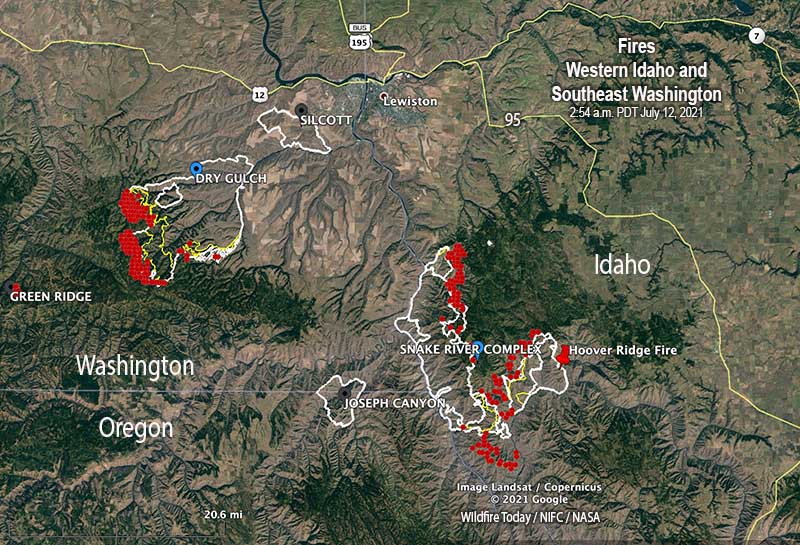8:30 a.m. MDT July 12, 2021

Wildfires are still very active where three states meet, Washington, Oregon, and Idaho.
Dry Gulch
Nearly all of the spread of the fire over the last two days has been on the southwest side. A mapping flight Sunday night found that it had grown to 55,050 acres, but has moved no closer to Lewiston, Idaho and is still 10 miles southwest of the city. The Dry Gulch Fire merged with the Lick Creek Fire on July 8 and they are now treated as one — Dry Gulch.
On Sunday evacuation warnings ( Level 2, get set) were in effect, but no actual evacuation orders (Level 3, leave now). (Very Brief Editorial: We need a national system of evacuation criteria that is uniform across the country, makes sense, and does not require training or explanation!)

The Dry Gulch Fire has been managed by a Type 2 Incident Management Team, but a Type 1 Team will assume command Monday, July 12.
Resources assigned on Sunday evening included 14 hand crews, no helicopters, 52 fire engines, and 4 dozers for a total of 536 personnel.
Snake River Complex
The 54,407-acre fire 12 miles south of Lewiston, Idaho is being managed by a Type 2 Incident Management Team. It is comprised of three fires that burned together, Shovel Creek, Captain John Creek, and Hoover Ridge. The growth over the last two days has been closer to each other as well as to the east and the south. It is bordered on the west side by the Snake River. The greatest spread Sunday was on the south side where the Shovel Creek Fire came close to the Salmon River. The east side of the Hoover Ridge Fire is being held by the Salmon River.
Approximately 438 residences are threatened.
From the Incident Management Team Sunday evening:
On the north end of the fire, resources continue to protect values at risk including primary structures and infrastructure around Waha Lake and Red Bird road. Tactics include a combination of indirect line followed up with burning in Madden Creek and around to the south. In the Craig Mountain area, resources are completing indirect fireline to the north. The Hoover Ridge fire resources continue to secure the northeast corner down to the Salmon River. Resources are still using a point protection strategy to burn around and secure values at risk in both the Salmon and Snake Rivers.
Resources assigned Sunday evening included 3 hand crews, no helicopters, and 6 fire engines for a total of 170 personnel.
Dixie Fire
The 15,323-acre Dixie Fire just east of Dixie, Idaho is not being completely suppressed by the Nez Perce-Clearwater National Forest. It is being managed by a Type 1 Incident Management Team. Resources that are 15% monitoring, 30% confining, 35% point protecting, and 20% suppressing the fire include 8 hand crews, 16 fire engines, and 4 helicopters for a total of 522 personnel. The same team is managing the nearby 898-acre Jumbo Fire. (map)
